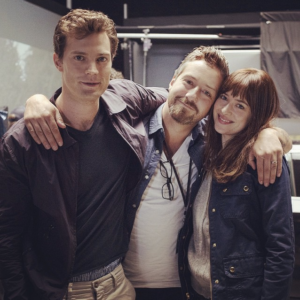
Christian Grey is leaning over, his hands braced on a table, with his back to Anastasia Steele. It’s the emotional climax of Fifty Shades of Grey: Christian and Ana have enjoyed a passionate and tumultuous romance, but it has led them both up to this point of insurmountable conflict. Ana is upset, questioning him, demanding to know why he can’t have sex like a “normal” person.

A short silence follows: the sound of 200 people holding their breath. It’s two days after Fifty Shades of Grey first hit theaters and almost all the seats are filled. Someone breaks first. The silence is filled with a single stifled, disbelieving snigger; and then, as if given unspoken permission, the rest of the theater is joining in and the collective laughter is drowning out whatever Ana says in response to Christian’s dramatic declaration.
It’s possible that there are a couple of dedicated Fifty Shades fans sitting somewhere in the back and fuming at the disrespectful response to a line that was lifted directly from the book. However, even if they did make themselves known, they would probably be drowned out by the rest of the crowd.
There have been two distinct types of laughter from the audience over the last two hours: pleasantly surprised laughter in response to Fifty Shades of Grey’s moments of goofy self-awareness and wry self-deprecation; and groaning, embarrassed laughter every time something awful, cheesy or clichéd is uttered. The audience swerves between laughing along with Fifty Shades of Grey, and laughing at it. Welcome to the experience of watching this movie.
Sam Taylor Johnson directing Fifty Shades of Grey
It’s no coincidence that Fifty Shades of Grey feels like a film that’s at war with itself. When author E.L. James’ agent Valerie Hoskins was negotiating with Universal over the movie rights, she said that her main goal was “to protect the material and its manifestations into movies. To make sure that, as E.L. said, she would be all over it like a rash.”

For once James’ description wasn’t at all florid, because her influence is indeed all over Fifty Shades of Grey like a rash. It’s a fungal infection that crops up awkwardly in patches amid a film that’s desperately trying to break free of its source material. Screenwriter Kelly Marcel and director Sam Taylor-Johnson were partially successful at turning a pretty terrible book into a coy, self-consciously humorous look at female sexuality and the emotional and political connotations of kink, but there are frequent moments in Fifty Shades of Grey where the film is jerked back into cringeworthy melodrama, as though someone has just tugged on the choke chain.
“[James] was given a lot of power, and she used every opportunity to flex that power,” an inside source told The Hollywood Reporter in an article detailing the author’s excessive interference. “It was really challenging to control E.L.’s — I don’t want to say ‘crazy’ but — impulsive instincts.”
A profile by Vanity Fair on the creative forces behind Fifty Shades of Grey corroborates this account and fleshes it out further. James would send Fifty Shades of Grey’s Oscar-winning costume designer Mark Bridges pictures of the jeans that Christian should wear and advice on how they should be tailored. Bridges says that he “took her suggestions seriously,” but that he was disappointed when the author vetoed the double-breasted suit that he had planned for Christian to wear when the character first appears in the film, on the grounds that it wasn’t sexy enough.

“She has such a powerful vision that if we changed even the colour of a dress it would really unsettle her,” Taylor-Johnson explained in an interview with HeyUGuys. “It was difficult being reminded about the arc and the story constantly.” Given the frequently baffling ups and downs of the plot and character arcs that James laid out, it’s little wonder that Taylor-Johnson didn’t much enjoy being forced to adhere to them.
Dakota Johnson as Anastasia Steele in ‘Fifty Shades of Grey’
“We battled all the way through,” Taylor-Johnson told Vanity Fair, referring to James’ habit of showing up on set every single day to offer her input. “She’d say the same. There were tough times and revelatory times. There were sparring contests. It was definitely not an easy process, but that doesn’t mean to say that it didn’t come out the right way.” The final caveat is a couple of negatives away from a declaration that Fifty Shades of Grey did come out the right way.
Taylor-Johnson also says that she had several people express surprise that she hadn’t just quit the project altogether, but after taking four years off following the release of Nowhere Boy to focus on her family, she didn’t have a wealth of options when she returned
